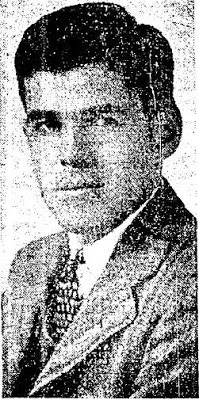Concerning this Keeler opus Todd Downing wrote in December: "My personal opinion is that it is too long, too complicated, too scientific, for anyone but a Robinson Crusoe." He added discouragingly: "Everyone to whom I have loaned it, including an anthropologist, has returned it unfinished."
 |
| Z-ray of death? |
So maybe Todd Downing bit off more than he could chew picking Matilda Hunter as his first Keeler. Downing later became, it should be noted, a warm admirer of the author. Not being able to resist a challenge, I decided, eighty-one years after Downing, to take a waltz with Matilda.
I've made it to page 104, a bit less than 15% of the novel (oh, didn't I mention that it's 741 pages of rather small print?). So far I'm pleased to say I don't yet find the novel an unscalable precipice. Though I have to say things have moved rather slowly (Keeler doesn't stint on such things as verbatim insurance policies and newspaper stories, and there's lots and lots of detailed conversation).
So far Keeler has introduced:
Victor Michaux, supposed inventor of the Z-ray machine, which supposedly emits what I believe are known to scientists as radioactive death ray thingummies (to use advanced technological terminology).
Jerry Evans, Chicagoan and hero of the tale, whose aunt
Matilda Hunter is killed by Michaux's Z-ray machine (supposedly), which was (supposedly) in a black satchel that she had brought to Jerry's rooms because Michaux had disappeared. The widow Hunter was Michaux's landlady and the satchel had been left with her. Oh, and she took out a $2500 insurance policy in nephew Jerry's favor. This, along with her death, makes a timely windfall for Jerry, who needs $2500 to marry
Carolle Harbison, niece of the wealthy
Peter Harbison.
Interestingly Jerry has just seen Michaux leave the Harbison premises (with the black satchel).
There's also a visiting Eastern cousin of Jerry's
T. Percy deVoy, a journalist who coincidentally has written about
Cyril Burthrick, English expert on radioactive death ray thingummies. Oh, and this gent has six fingers on each hand ("Polydactylic, you know," explains deVoy. "Geniuses frequently are!").
 |
| Todd Downing demurred with his first Keeler yet came to admire the author |
I will keep you posted, providing as well further tidbits about the splash this novel made back in 1931. There's actually quite a bit of interesting background out there on this exceptionally lengthy detective novel.
And, fear not, I'll be doing at least one (I hope two) additional, non-Keeler book this week as well.
Man cannot live by Keeler alone, even at nearly 750 pages of the author's super-stupendous, patented webwork plotting.

I bought THE RIDDLE OF THE TRAVELLING SKULL from Ramble House as an e-book. I rather look forward to it.
ReplyDelete741 pages?? Better you than me.
ReplyDeleteHard to believe, I know, but Keeler remains a complete unknown to me (or rather, I've read lots of interesting blog pieces about him and his work but have never come across an actual book by him). Assuming that this is probably not the place for a neophyte to get 'stuck', where would you suggest? Thanks in advance Curt.
ReplyDeleteSergio
I would never have recommended you start with ...MATILDA HUNTER. Or THE BOX FROM JAPAN which is even longer! I always recommend one of the more straightforward (is it possible to use that adjective when talking about Keeler?) books. I'd say THE WASHINGTON SQUARE ENIGMA, THE GREEN JADE HAND or THE RIDDLE OF THE TRAVELING SKULL are all better starting points for the Keeler novice and all more action oriented. SING SING NIGHTS is even better because it's the perfect example of the story-within-the-story kind of book he enjoyed writing. I haven't tackled this one yet, though I have a copy. The only Keeler book I never finished (nor will I attempt to try again)was THE VANISHING GOLD TRUCK. If ever there was an unreadbale book that is it.
ReplyDeleteI own 5 Keeler: The Fourth King, The Peacock Fan, Sing Sing Night, The Marceau Case, X Jones of Scotland Yard. The first three date back about sixty years ago, the last two were published two or three years ago, but since then nothing. I expected at least ceased, "Marceau The Series", but has not been published else. And the small publishing house that published with these two, five titles in all, of the highest quality, and that he expected sales returns probably others not spending anything on advertising, closed publications. Too bad!
ReplyDeleteSome of the Prologue Ebooks would be a good start too, The 4th King, Keeler's closest thing to pure Edgar Wallace, or The Yellow Zuri.
ReplyDeleteBut so far, I don't find Matilda Hunter so impossible, though it's insanely long! Now Marceau and X. Jones sound really bizarre, not to mention the later ones from the 1940s, where he just seems to have withdrawn completely into Keelerland.